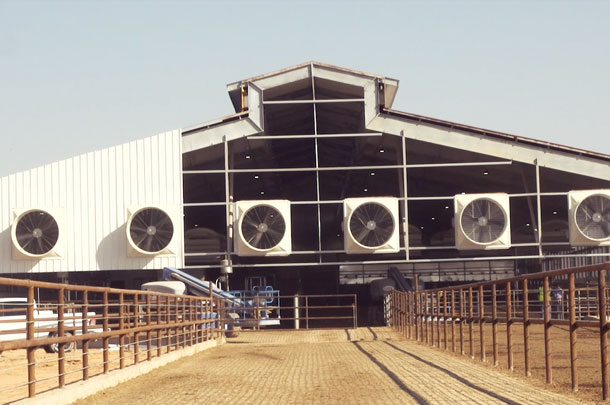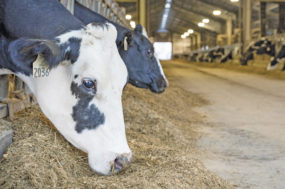As we move into the new year, many take stock of goals, growth areas and opportunities for improvement across their dairy operations. In some cases, that includes making smart investments that leave a small financial footprint but have wide-ranging impacts throughout your dairy.
One such upgrade to consider is ventilation and cooling. Now, it’s important to consider that ventilation upgrades and investments can be tackled in a tiered, financially sensitive way that can actually help dairies create smaller test scenarios in segments of their operation before fully investing in a comprehensive environmental system.
The following list takes you through five specific approaches to ventilation technology investments that can deliver positive results for your dairy in areas from productivity to reproduction to overall animal health and wellness.
1. Targeting the parlor and holding area
Before we go into detail here, it’s important to note that items one and two on this list are based completely on preference. Both represent great options for taking the first step into making a ventilation and cooling infrastructure investment.
For smaller herds, the parlor and holding area is definitely a great place to direct a ventilation infrastructure investment. Since the parlor is a consolidated area where most of your milking herd congregates and spends time during the course of the day, it’s the one spot on the operation where a ventilation upgrade can touch nearly every cow in your herd.
A basic, efficient ventilation strategy for a milking center incorporates pressurizing fans in the parlor combined with natural ventilation, with the addition of some recirculating fans that include soakers and/or high-pressure fogging units that achieve evaporative cooling. It is essential an air exchange is inferred to remove the added humidity levels in the parlor and holding area. Without this, a sauna situation will develop. The goal of those recirculating fans is to achieve air speeds of 5 MPH at the cow level.

Positive-pressure fans equipped with high-pressure fogging units over this rotary parlor provide fresh, cool air and an evaporative cooling effect on cows while milking. Photo courtesy of VES.
2. Dedication to cooling dry cows
The stigma of dry cows being a non-productive cost center on dairies is one that is thankfully going by the wayside because investing in proper ventilation and cooling for your dry cow pens can have significant positive upstream and downstream implications on your dairy.
First, this is the lowest-cost investment you can make, due to the fact that about 10% to 15% of your overall herd is going to be in the dry cow stage at any given time. And, much like the parlor and holding area, the starting point is overhead recirculating fans combined with feedline soakers or equipped with high-pressure fogging units.
By improving ventilation and increasing overall comfort for your dry cows, research has found it’s possible to achieve higher productivity and milk quality when those animals begin lactation. Multiple studies conducted at the University of Florida indicate calves from heat-stressed dry cows are more likely to have health and wellness challenges, reduced growth, lower reproduction rates and lower first-lactation milk production. When cows are comfortable, lying time increases. This results in increased blood flow to the udder, which is important in overall udder development and growth. Improved feed consumption and utilization is also a byproduct of dry cow comfort, tied to appropriate ventilation solutions.
3. Fans in the freestall barn
While the freestall barn will require a larger investment, it’s the best way to cover the vast majority of the herd with fresh air at the cow level for the longest period of time. Again, the first step in ventilating a freestall barn efficiently is adding recirculating fans, plus fence line soakers. In more arid climates, optional high-pressure fogging capabilities are included.
If your budget is hospitable to additional equipment, our fourth recommendation is worth considering.
 While direct-drive fans push fresh, cool air into the parlor holding area, overhead recirculating fans direct that air down to the cow level and toward a bank of exhaust fans that pull warm, humid air out of the facility. Photo courtesy of VES.
While direct-drive fans push fresh, cool air into the parlor holding area, overhead recirculating fans direct that air down to the cow level and toward a bank of exhaust fans that pull warm, humid air out of the facility. Photo courtesy of VES.4. Consider a combination system
Recirculating fans are the foundation by which efficient and cost-effective ventilation is built. However, there’s much more to consider for maximizing overall ventilation effectiveness, especially in hotter, more humid climates.
The first element to consider is developing a negative-pressure living area where fresh air drawn through a properly sized inlet is directed to the cows’ living space by recirculation fans and then removed by exhaust fans. An additional design that is working successfully in tunnel-ventilated barns from 500 feet up to more than 1,000 feet long is using pressurizing fans to drive fresh, cool air into the structure, segmentally along its length, and then onto recirculating fans that force fresh air down to the cow level. This ensures the cows experience fresh air wherever they are along the barn’s entire length.
There are a number of different options for considering power-ventilation combinations, depending on the design of your barn or structure, but there are solutions that work great regardless of climate and geography.
 Exhaust fans work in concert with inlet and recirculating fans to pull hot, humid air out of the parlor or living environment. Photo courtesy of VES.
Exhaust fans work in concert with inlet and recirculating fans to pull hot, humid air out of the parlor or living environment. Photo courtesy of VES.5. Make the future comfortable
Finally, much like focusing on the dry cow holding pen, another smaller demographic within the dairy is calves younger than 6 months old. Young calves benefit significantly from fresh air directed to their level and actively removed from their environments. Those benefits range from improved respiratory health, better feed intake and conversion, and in some instances, better coping ability with future exposure to hot, humid weather conditions and borderline heat stress.
If you already have ventilation and cooling components installed across your operation, one of the easiest investments you can make is the investment of time to ensure that all of your equipment is fully operational, clean and meeting current ventilation standards.
And, regardless of which solution or investment level might be best for your dairy, it’s imperative to consult a professional dairy ventilation provider who can provide on-farm consultation and design services that can help determine the right ventilation investment for your operation.








